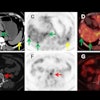Dear Molecular Imaging Insider,
This issue of the Insider offers the first exclusive look at a preliminary study by German researchers that suggests carbon-11 (C-11) choline PET/MRI may offer an alternative to PET/CT for restaging of prostate cancer with equal, if not better, diagnostic performance and less radiation exposure.
The comparison between the two hybrid modalities comes from the Institute of Radiology at Technische Universität München. The analysis found choline-PET/MRI detected more suspicious lesions among 31 recurrent prostate cancer patients than PET/CT. However, PET/MRI and PET/CT had similar results in detecting lymph node metastases and bone metastases.
Read more about the study by clicking here.
In other noteworthy studies, a combination of 1.5-tesla MRI, FDG-PET, and cerebrospinal fluid data with routine clinical tests significantly increases the ability to predict whether people with mild cognitive impairment will progress to Alzheimer's disease. The study from Duke University Medical Center reduced the misdiagnosis rate of very early-stage Alzheimer's from 41.3% to 28.4% with the additional information.
In regulatory news, the U.S. Centers for Medicare and Medicaid Services has proposed a new policy that could make it easier for new oncology PET tracers to gain reimbursement. However, the amendment to current rules to have local Medicare administrative contractors decide coverage within their respective jurisdictions will not apply to tracers used for neurology and cardiology applications.
Also, the U.S. Food and Drug Administration set a December 12, 2015, deadline for PET drug manufacturers to operate under an approved new drug application, abbreviated new drug application, or investigational new drug submission to continue to make their products.
Finally, two Japanese studies have found that the radiotracer C-11 methionine with PET/CT can help clarify negative or inconclusive FDG-PET findings in multiple myeloma patients, as well as differentiate between atypical and typical pituitary adenomas.
Everyone at AuntMinnie.com would like to wish our loyal readers a very happy holiday season and a healthy and prosperous 2013. We look forward to having you visit the Molecular Imaging Digital Community in the coming year to stay informed on the latest news and precedent-setting research.



















